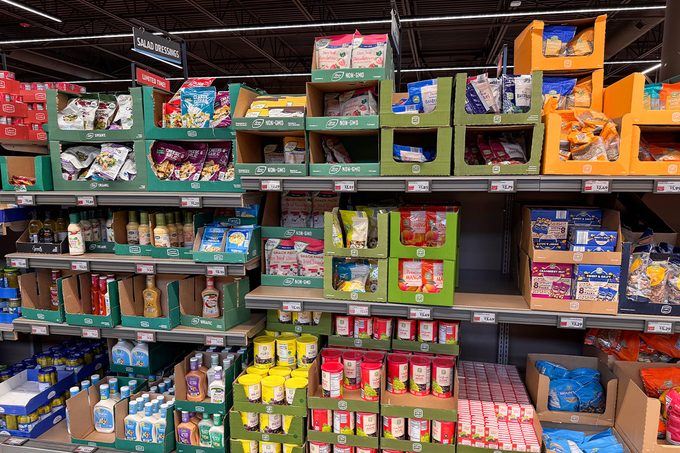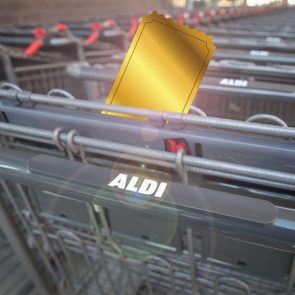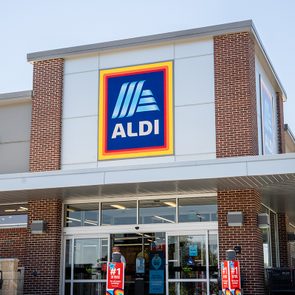It's more than just an Aldi thing

Here’s Why Aldi’s Shelves Are Stacked with Boxes

Listen, it’s totally OK to love Aldi while also acknowledging the store’s quirks. Like those hyper-fast cashiers at checkout, the exceptionally large UPC codes on their inventory and, of course, the delightful (but fully random) Aisle of Shame. And, seriously, why are Aldi’s shelves stacked with boxes?
It’s cool, though, because Aldi is the place to be when you want cheap groceries and, let’s face it, “fun stuff.” I mean, we all have our quirks, right? It’s charming in a way. But still, what is up with all of those boxes? Costco and BJ’s warehouses also often keep items in boxes—and they’re even larger than Aldi’s—yet no one blinks an eye. Well, there is a perfectly logical explanation for them, and we’re about to reveal all.
Get Reader’s Digest’s Read Up newsletter for more Aldi news, humor, travel, tech, cleaning and fun facts all week long.
Why are Aldi’s shelves stacked with boxes?

Literally every “oddity” about Aldi involves saving you money. And those stacked-up boxes on shelves? Those are absolutely part of it.
“Aldi tries to focus on being a discount supplier and needs to keep the costs in the supply chain as low as possible in order to keep prices competitive,” says Dan Wilderness, founder of The Financial Wilderness. “One of the biggest costs is staff, so by design Aldi wants to approach limiting the amount of time needed to spend out on the floor restocking.”
This means that instead of pulling each and every item out of the shipping boxes and onto a shelf, they simply open the box and use it as the display. Done and done.
How does this save money?
It essentially means Aldi doesn’t have to staff as many employees to stock the shelves, which saves them money on overhead. These savings are then passed along to you, the consumer, in the form of lower prices.
“Putting out boxes has been their answer to this challenge,” Wilderness says. “It means items can be put straight out on the floor directly from the delivery truck in the manner they arrive. Not only is less time needed for staff to arrange the products into a display, but also when a box runs out, it’s very easy for them simply to lift a box away to enable access to the full one underneath.”
What does Aldi do with the empty boxes?
Aldi very much takes a “waste not, want not” approach to everything. They’re very committed to donating unsold food. In the same vein, they do their best to make sure those boxes don’t end up in a landfill.
“When boxes are empty, they usually get recycled, or customers simply reuse them,” says Marc Mezzacca, founder and savings expert at CouponFollow. “Since Aldi charges for bags, you’ll often see customers pack their groceries in them. It’s simple, it’s efficient and it’s one of the ways Aldi reduces waste and keeps in line with its no-frills policy.”
RELATED:
- This Is the Best Time to Go to Aldi for the Steepest Discounts and Biggest Selection
- If You See a White Label or Tag at Aldi, This Is What It Means
- If You See a Red Tag on an Item at Aldi, This Is What It Means
About the experts
|
Why trust us
At Reader’s Digest, we’re committed to producing high-quality content by writers with expertise and experience in their field in consultation with relevant, qualified experts. We rely on reputable primary sources, including government and professional organizations and academic institutions as well as our writers’ personal experiences where appropriate. We verify all facts and data, back them with credible sourcing and revisit them over time to ensure they remain accurate and up to date. Read more about our team, our contributors and our editorial policies.
Sources:
- Dan Wilderness, founder of The Financial Wilderness; interviewed, June 2025
- Marc Mezzacca, founder and savings expert at CouponFollow; interviewed, June 2025



